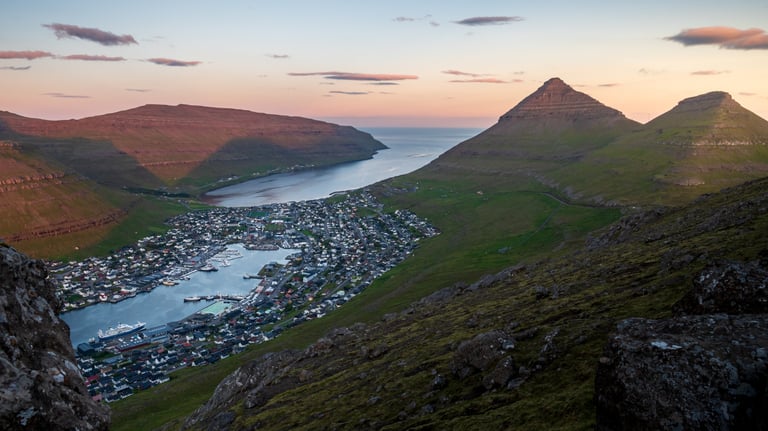Best Time to Visit the Faroe Islands for Photography
FAROE ISLANDS PHOTOGRAPHY


Discover the Ideal Seasons for Capturing Iconic Landscapes, Wildlife, and Unique Weather Conditions
Each season in the Faroe Islands offers something special for photographers, from vibrant greenery in summer to stormy skies in autumn and snow-draped mountains in winter. Here’s what you can expect in each season:
Spring: Awakening the
Landscapes (March to May)
Spring is a time of renewal in the Faroe Islands, with longer days and dynamic weather that makes for dramatic photography.
Melting snow reveals lush green landscapes, and waterfalls are at their most powerful.
What to Expect:
Puffins and other seabirds begin nesting in late April, perfect for wildlife photography.
Waterfalls like Múlafossur and Fossá are in full flow.
Temperatures range from 6°C to 9°C (43°F to 48°F), with a mix of sunshine, rain, and fog.
Photography Tips:
Use ND filters to capture long exposures of waterfalls.
Take advantage of changing weather for moody and atmospheric shots.
Summer: Endless Days and Vibrant Landscapes (June to August)
Summer is the most popular season for photographers visiting the Faroe Islands. With up to 22 hours of daylight, the “midnight sun” offers extended golden hours for capturing stunning light.
What to Expect:
Iconic locations like Sørvágsvatn (the lake above the ocean) and Kalsoy’s Kallur Lighthouse are more accessible.
Puffins are abundant, making it a prime time for wildlife photography.
Temperatures average 13°C (55°F), with relatively mild weather.
Photography Tips:
Plan shoots during golden hours for soft, warm light.
Use a wide-angle lens to capture expansive landscapes.
Hike to less crowded spots early in the morning or late at night for solitude.
Autumn: A Photographer’s Dream (September to November)
Autumn brings warm golden tones and moody skies, making it a favorite season for atmospheric photography. With fewer tourists, it’s an ideal time to explore the islands’ tranquil beauty.
What to Expect:
Vibrant autumn colors dominate the hills and valleys.
Stormy seas and dramatic light shifts offer unique opportunities for creative compositions.
Daylight decreases from 13 hours in September to 7 hours by November, making golden hour more accessible.
Photography Tips:
Experiment with long exposures to capture crashing waves.
Focus on the interplay of light and shadow during stormy conditions.
Bring weatherproof gear to protect your equipment from frequent rain.
Winter: Rugged Beauty and Tranquility (December to February)
Winter transforms the Faroe Islands into a serene wonderland. Snow-capped mountains, icy cliffs, and the possibility of Northern Lights create a magical atmosphere for photographers.
What to Expect:
Only 5 hours of daylight during the winter solstice, but the low sun creates beautiful, soft light.
Snow-covered landscapes and icy fjords make for minimalist compositions.
Temperatures hover around 3°C (37°F), with strong winds and occasional storms.
Photography Tips:
Use a sturdy tripod for long exposures in windy conditions.
Focus on capturing the tranquility and stark beauty of winter landscapes.
Keep your camera batteries warm to prevent them from draining quickly.
Essential Photography Gear for the Faroe Islands
To make the most of your trip, pack the following:
Camera and Lenses:
Wide-angle lens (16-35mm): For expansive landscapes.
Telephoto lens (70-200mm): For wildlife and compressing perspectives.
Prime lens (e.g., 50mm): For sharp, versatile shots.
Filters:
ND Filters: Essential for long exposures of waterfalls and waves.
Polarizing Filter: Enhances skies and reduces glare.
Accessories:
Sturdy Tripod: Crucial for windy conditions and long exposures.
Drone: The Faroes are drone-friendly, but follow local regulations.
Backup Gear: Extra batteries, memory cards, and a portable hard drive.
Clothing:
Layered Clothing: Base layer, insulating mid-layer, and waterproof outer layer.
Waterproof Pants and Hiking Boots: Essential for navigating rocky, wet terrains.
Gloves and Hat: Keep warm, especially during winter.
Waterproof Backpack: Protects your gear from sudden downpours.
Tips for Success:
Check Weather Forecasts: Websites like YR.no and apps like Windy can help you predict conditions and plan your shots.
Scout Locations: Use tools like Google Maps and social media to research viewpoints, such as Hvítahamar or Lake Sørvágsvatn.
Timing is Everything: Plan to shoot during golden hours (sunrise and sunset) for the best lighting conditions.
Stay Flexible: The Faroe Islands’ weather can change rapidly, so be ready to adapt your plans.
Why the Faroe Islands Are a Photographer’s Paradise
No matter when you visit, the Faroe Islands offer unparalleled opportunities to capture breathtaking landscapes, dramatic light, and unique wildlife. Each season presents its own set of challenges and rewards, making every trip a new adventure.
By understanding the best times to visit and preparing accordingly, you’ll be ready to create stunning photographs that showcase the magic of this Nordic gem.
Ready to Plan Your Faroese Photography Adventure?
As a native Faroese and experienced photography tour guide, I’ll take you to the best locations at the right times to maximize your shooting opportunities. Whether you’re looking for iconic spots like Múlafossur or Fossá Waterfall or hidden gems only locals know, my guided tours are tailored to help you capture the essence of the Faroe Islands.
Book your tour today at www.bogiolsen.fo and start planning your photography journey!
© 2025 Bogi Olsen Photography | Faroe Islands | All rights reserved | Privacy Policy
Faroe Islands photography tours, workshops, and private guiding by local photographer Bogi Olsen.
Certified Faroese guide • 5★ client reviews
